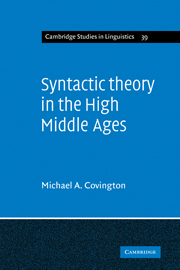Book contents
- Frontmatter
- Contents
- SOLI DEO GLORIA
- Preface
- 1 Introduction
- 2 Before the Modistae
- 3 Modistic grammar
- 4 Syntactic structure
- 5 Modistic treatments of particular syntactic problems
- 6 Subsequent developments
- Appendix: Notes on certain questions of authorship
- Notes
- Bibliography
- Index of names
- Index of topics
- Index of Greek terms
3 - Modistic grammar
Published online by Cambridge University Press: 04 August 2010
- Frontmatter
- Contents
- SOLI DEO GLORIA
- Preface
- 1 Introduction
- 2 Before the Modistae
- 3 Modistic grammar
- 4 Syntactic structure
- 5 Modistic treatments of particular syntactic problems
- 6 Subsequent developments
- Appendix: Notes on certain questions of authorship
- Notes
- Bibliography
- Index of names
- Index of topics
- Index of Greek terms
Summary
The Modistae were a group of grammarians and logicians,1 active principally at Paris during the second half of the thirteenth century, who held that in addition to having a pronunciation and a meaning, every word has a set of properties called modi significant (modes of signifying) that determine how the particular meaning is encoded into the language. For example, the verb currere, ‘to run’, and the noun cursus, ‘a run’, signify the same thing – the act of running; the difference between them is that they signify it in different ways (under different modes). Currere signifies running conceived of as an act or change in progress {per modum fluxus et'fieri); cursus signifies it as an enduring entity {per modum habitus et permanentiae). Modes of signifying account not only for the differences between the various parts of speech, but also for all the other properties of a word that reside neither in its meaning (in the strict sense) nor in its pronunciation – including such things as gender, number, case, and form (simple or complex).
The Modistae
Only a small part of the vast literature of medieval grammar has been printed or even read through in modern times. Nonetheless, by studying many unedited manuscripts as well as all available printed editions, Pinborg (1967) has been able to trace the main outlines of the development of modistic grammar, and subsequent research has contributed many details to the picture. In this section I shall summarize and update Pinborg's results, with emphasis on the medieval grammarians whose works constitute the data for the present study.
- Type
- Chapter
- Information
- Syntactic Theory in the High Middle AgesModistic Models of Sentence Structure, pp. 22 - 40Publisher: Cambridge University PressPrint publication year: 1984



